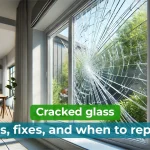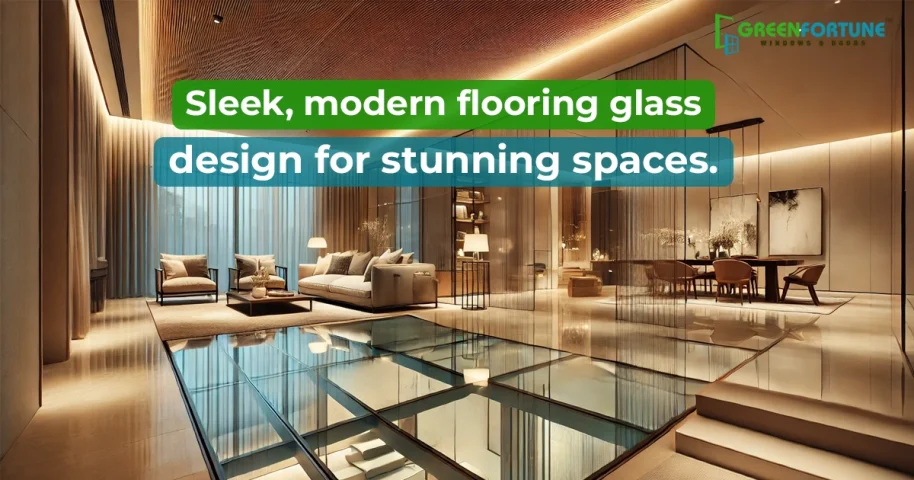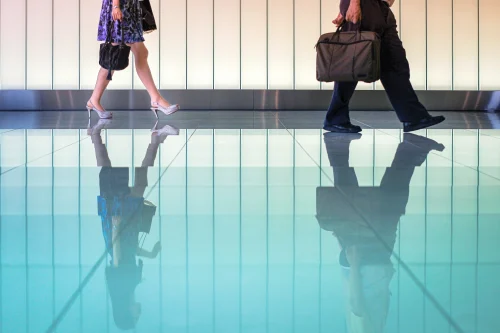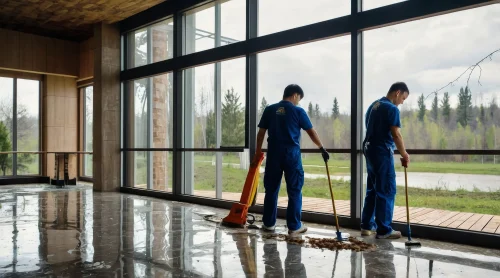
What is Floating Glass? Pros & Cons
April 1, 2025
Cracked Glass: Causes, Fixes, and When to Replace It
April 2, 2025Glass flooring is more than just a luxurious addition to modern interiors; it is a transformative element that offers aesthetic appeal, functionality, and a touch of innovation.
While it may not be as common as wood, tile, or carpet flooring, flooring glass design has steadily gained popularity for its unique features and applications in both residential and commercial spaces.
What is Flooring Glass?
Flooring glass is a specially designed type of glass used for floors, offering a sleek and modern aesthetic to both residential and commercial spaces.
It is highly durable, engineered to bear significant weight, and adds a sense of spaciousness by allowing light to pass through. This type of flooring is not only functional but also a bold design statement that can elevate any space's appearance.
Different Types of Glass Flooring
When discussing glass flooring, it's essential to understand the variety available. Not all glass floors are the same, and each type comes with its own set of benefits. Below is a comparison table showcasing the main types:
Type of Glass | Features | Best Used In |
Tempered Glass | 5x stronger than standard glass, impact-resistant | High-traffic areas, balconies, walkways |
Laminated Glass | Two or more layers of glass with an interlayer for added safety | Residential homes, offices, stairs |
Frosted Glass | Provides privacy, diffuses light, softens the appearance | Bathrooms, commercial offices, or partitions |
Transparent Glass | Clear visibility, modern look, allows light to pass through | Staircases, floors between levels, museums, showrooms |
Treaded Glass | Slip-resistant surface for enhanced safety | Staircases, commercial buildings, spaces prone to moisture like bathrooms |
Coloured Glass | Available in various tints or shades, aesthetic flexibility | Contemporary residential projects, hotels, and galleries |
Statistical Insight:
According to the Global Construction Glass Market Report 2023, the glass flooring segment is expected to grow at a compound annual growth rate (CAGR) of 7.1% over the next five years due to the rising trend of transparent architectural designs.
Where You Can Use It
Glass floors aren’t limited to modern art galleries or high-end commercial spaces; they’re making their way into homes, offices, and other settings. Some examples include:
- Residential Homes: Many homeowners are now using glass flooring designs in areas such as mezzanines, lofts, and walkways between rooms. It’s especially popular in contemporary homes that emphasize open spaces and natural light.
- Commercial Buildings: High-end retail stores, office buildings, and restaurants often use glass floors in their lobbies or as design features between multiple levels. This creates a sense of spaciousness and offers a "wow" factor to visitors.
- Outdoor Applications: Outdoor glass flooring is often seen in swimming pools with glass walkways or terraces, where the view of the water below enhances the aesthetic appeal.
Also Read: Advantages of Choosing Flooring Glass for Stylish Interiors
Data Insight:
A survey of architects from the Glass Association of North America (GANA) shows that 45% of commercial architects recommend glass flooring for projects where aesthetics and natural light are primary concerns.
Is It Safe?
The first concern people often have with glass for flooring is safety. Rest assured, modern glass flooring is designed with safety in mind.
- Tempered Glass: This type of glass is heated and cooled rapidly, making it much stronger than standard glass. It can withstand large amounts of pressure and is five times stronger than regular glass.
- Laminated Glass: With an interlayer between glass sheets, laminated glass holds together even if shattered, ensuring it doesn’t break into sharp, dangerous pieces.
- Slip Resistance: Flooring glass is often treaded or treated with anti-slip patterns or coatings, making it safe even in high-moisture areas such as bathrooms or kitchens.
Safety Test Data: Tempered glass used in floors can hold up to 700 lbs per square foot, far surpassing the typical weight load of standard flooring, which ranges from 200-250 lbs.
Cool Features
- Light Transmission: One of the biggest benefits of glass flooring is its ability to transmit light. It’s a natural light solution that opens up your space, reduces reliance on artificial lighting, and creates an open, airy feel.
- Customization: Glass flooring is highly customizable. You can choose between various thicknesses, colors, textures, and even patterns to fit the design of your space.
- Modern Design Aesthetic: Glass floors provide a sleek, minimalist look that complements contemporary spaces. Its unique appeal makes it a favorite among high-end homeowners and architects.
Fact:
Glass flooring can transmit as much as 90% of light, which is why it’s often used in multi-level homes or offices to allow light to pass from one level to another.
Also Read: Why Red Oxide Flooring is Making a Comeback in Modern Homes
Easy Cleaning Tips
Despite their fragile appearance, glass floors are relatively easy to maintain, though they do require regular attention to keep them looking their best.
- Basic Cleaning: Use a microfiber mop or a vacuum to remove dust particles. Avoid dragging furniture over the floor as it can cause scratches.
- Non-abrasive Cleaners: Opt for non-abrasive glass cleaners or a mixture of vinegar and water. Avoid harsh chemicals that could damage the surface.
Polishing: To maintain the shine, use glass polishers periodically. These will help remove minor scratches and keep the surface looking sleek and clean.
Is It Worth the Cost?
Installing glass floors may seem expensive, but the benefits can outweigh the costs, especially in terms of long-term value and aesthetic appeal.
Cost Breakdown of Glass Flooring Types:
Type of Glass | Average Cost (per sq. ft.) | Installation Costs |
Tempered Glass | ₹3,500 - ₹6,000 | ₹1,500 - ₹2,000 |
Laminated Glass | ₹4,000 - ₹7,500 | ₹1,800 - ₹2,500 |
Frosted Glass | ₹3,000 - ₹5,500 | ₹1,400 - ₹1,800 |
Is it worth it?
In high-end real estate markets, homes or commercial spaces with features like glass floors see a potential property value increase of up to 7-10%.
For many, the unique look and durability of glass flooring are well worth the investment, especially when compared to traditional materials like wood or carpet that require more upkeep.
Conclusion
Installing flooring glass designs can significantly elevate the appearance of your space, adding both light and luxury. Whether for residential or commercial use, glass floors offer a modern design aesthetic, long-term durability, and a unique solution for enhancing interior spaces.
While it may come with a higher price tag, the visual appeal, light transmission, and customization options make it a worthwhile investment that adds value to any property.
Enhance Your Space with Green Fortune
Transform your interiors with high-quality uPVC windows and doors, or explore custom glass solutions that enhance both style and energy efficiency. At Green Fortune, we offer durable, eco-friendly products, including glass windows, sliding doors, and soundproof options that are perfect for any home or office space.
Ready to take your design to the next level? Visit Green Fortune today and discover the perfect combination of functionality and style!
FAQs
1. Is glass flooring suitable for high-traffic areas?
Yes, especially if you opt for tempered or laminated glass, which is designed to handle heavy foot traffic. The surface strength and durability make it a good choice for commercial spaces.
2. Can glass floors scratch easily?
While glass floors are durable, they can still get scratched if not maintained properly. Regular cleaning and avoiding dragging heavy objects across the surface can minimize damage.
3. Are glass floors slippery?
Glass floors can be slippery, but treaded or frosted glass offers improved grip. Anti-slip coatings can also be applied to further enhance safety.
What’s the average lifespan of glass floors?
With proper care, glass flooring can last up to 20-30 years, depending on the type of glass and the location in which it’s installed.










